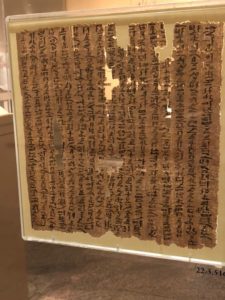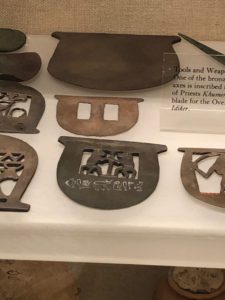Hello, and welcome to my tour. My name is Perel, but you can call me Perri. Today we will be talking about Egyptian art and the use of Hieroglyphics/hieroglyphs within them. Hieroglyphics was the written language of Ancient Egypt. “It was in form of objects–animals, plants, and household items–that the ancient Egyptians saw around them every day.” (Teeter) 
The second piece of ancient Egyptian hieroglyphics that we’ll look at is papyrus and the hieroglyphics written on it. Papyrus is a plant that was used for a number of objects, but the most important us was as a “writing surface” for things like “household and administrative documents, letters, contracts and other legal texts, illustrated narratives, and religious texts.”
 This piece of papyrus has hieroglyphics on it since that was the only form of writing that was available. There are more than 800 used hieroglyphics, but the most common are the twenty-four that are used to sound out words (like the English letters).
This piece of papyrus has hieroglyphics on it since that was the only form of writing that was available. There are more than 800 used hieroglyphics, but the most common are the twenty-four that are used to sound out words (like the English letters).
 Next we are going to look at the amulets. These were put on jewelry, put around the house to beautify the dwelling, or buried with a mummy to have positive energy. Many Egyptians carried them around as a form of good luck and to bring positive energy. Some of the amulets had writing on it, hieroglyphics, to write exactly what energy they wanted the amulets to bring them. They were the perfect thing to carry around because of their size, they were convenient.
Next we are going to look at the amulets. These were put on jewelry, put around the house to beautify the dwelling, or buried with a mummy to have positive energy. Many Egyptians carried them around as a form of good luck and to bring positive energy. Some of the amulets had writing on it, hieroglyphics, to write exactly what energy they wanted the amulets to bring them. They were the perfect thing to carry around because of their size, they were convenient.
 The next thing we’ll look at is “Mummy Mask of a Woman with a Jeweled Garland”. THis was a mask placed over the mummy before it was placed in the tomb. There are paintings all around it to tell the story of the person in the mummy, to bring good energy to the persons transition to the afterlife, and to beautify the mummy so that the person is honored. Within the beautiful painting there are hieroglyphics. This is done to explain some of the painting, to give some positive words, and to identify the person within the mummy.
The next thing we’ll look at is “Mummy Mask of a Woman with a Jeweled Garland”. THis was a mask placed over the mummy before it was placed in the tomb. There are paintings all around it to tell the story of the person in the mummy, to bring good energy to the persons transition to the afterlife, and to beautify the mummy so that the person is honored. Within the beautiful painting there are hieroglyphics. This is done to explain some of the painting, to give some positive words, and to identify the person within the mummy.
 The last piece we are going to look at are these weapons. These were used by the Egyptians in battle. The curved edge was sharp and was a knife to fight the enemies. The hieroglyphics were engraved onto these items to give the fighter good luck in battle, and to mark who’s weapon is whoms. Each hieroglyph can be an entire word so even though there are about ten hieroglyphics on the piece it could say numerous things.
The last piece we are going to look at are these weapons. These were used by the Egyptians in battle. The curved edge was sharp and was a knife to fight the enemies. The hieroglyphics were engraved onto these items to give the fighter good luck in battle, and to mark who’s weapon is whoms. Each hieroglyph can be an entire word so even though there are about ten hieroglyphics on the piece it could say numerous things.
This tour was designed to show the different ways in which hieroglyphics were used and the different objects it was used on and I hope I accomplished that.
- Kamrin, Janice. “Papyrus in Ancient Egypt.” In Heilbrunn Timeline of Art History. New York: The Metropolitan Museum of Art, 2000–. http://www.metmuseum.org/toah/hd/papy/hd_papy.htm (March 2015)
- Patch, Diana Craig. “Egyptian Amulets.” In Heilbrunn Timeline of Art History. New York: The Metropolitan Museum of Art, 2000–. http://www.metmuseum.org/toah/hd/egam/hd_egam.htm (October 2004)
- “Rosetta Stone.” Britannica Online Academic Edition, 2018, pp. Encyclopædia Britannica, Inc.
- Teeter, Emily. “Egyptian Hieroglyphs.” Calliope, vol. 14, no. 9, 2004, pp. 7–10.
- The British Museum, “Paintings from the Tomb-chapel of Nebamun,” in Smarthistory, August 29, 2016, accessed December 12, 2018, https://smarthistory.org/paintings-from-the-tomb-chapel-of-nebamun/.


